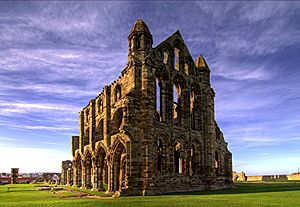Ælfflæd of Whitby facts for kids
Quick facts for kids Saint Elflaeda of Whitby |
|
|---|---|

|
|
| Died | 714 |
| Feast | 8 February |
Saint Ælfflæd (born 654, died 714) was a very important woman in early English history. She was the daughter of King Oswiu of Northumbria and Queen Eanflæd. Ælfflæd became the leader, or abbess, of Whitby Abbey. This was a famous monastery for nuns, known for their skills in medicine.
Ælfflæd took over as abbess after her relative, Hilda, passed away in 680. At first, she shared the role with her mother. Later, she led the abbey all by herself. People especially knew Ælfflæd for her amazing skills in surgery. She also cared for patients personally, just like Hilda did.
Contents
Ælfflæd's Early Life
Most of Ælfflæd's life was spent as a nun, living in a religious community. When she was only about one year old, her father, King Oswiu of Northumbria, made a special promise. He had won a big battle, the Battle of the Winwæd, against Penda of Mercia. To thank God, he gave his daughter Ælfflæd to Abbess Hilda.
Hilda raised Ælfflæd at Hartlepool Abbey. Later, around 657 or 658, Hilda left to start a new monastery called Whitby Abbey. Ælfflæd went with her to this new home.
Leading Whitby Abbey
When Hilda died in 680, Ælfflæd and her mother, Eanflæd, became joint abbesses of Whitby. This meant they led the abbey together. In the late 680s, Ælfflæd became the sole abbess. She remained in charge until her death in 714.
During this time, the church in Northumbria was very powerful and wealthy. It was a place where important people, like princesses, lived and worked. For example, Abbess Ælfflæd once shared a meal with Saint Cuthbert, a famous saint from Lindisfarne.
Her Healing Touch
Ælfflæd was known for her kindness and healing abilities. One story tells how she was very sick with a crippling disease. She thought about Saint Cuthbert and wished she had something of his. She believed it would help her get better.
Soon after, a messenger arrived with a gift from Cuthbert. It was a linen belt. Ælfflæd put the belt on. Within just three days, she was completely healthy again! This story shows how much faith people had in her and in Cuthbert.
Important Connections
Ælfflæd was also an important figure in politics. She was connected to Bishop Wilfrid, another key religious leader. She played a big part in helping her nephew, Osred, become king in 705. Osred was the son of Aldfrith.
From the death of her brother, Ecgfrith, in 685 until her own death, Ælfflæd was a very influential person. She was seen as a wise advisor and a source of comfort for the whole kingdom.
One letter written by Ælfflæd still exists today. It was sent to Adolana, another abbess. In this letter, Ælfflæd asks for help for a fellow abbess who wanted to go on a pilgrimage to Rome. A pilgrimage is a special journey to a holy place. This letter shows that Whitby Abbey had connections with other religious communities across Europe.
Legacy and Recognition
Many important people of her time praised Ælfflæd. Bede, a famous historian, wrote about her great holiness and devotion. Stephen of Ripon called her "the consoler of the whole kingdom and the best counsellor."
Ælfflæd was considered a saint. Her feast day, a special day to remember her, is celebrated on February 8. She was buried at Whitby Abbey. A book about her life, called the Vita sanctae Elfledae, was written much later.
In the 1920s, archaeologists found old building foundations at Whitby. They also found two special memorial stones. People believe these stones mark the deaths of Saint Ælfflæd and Cyneburgh, who was a queen.
See Also
- Anglo-Saxon saints

